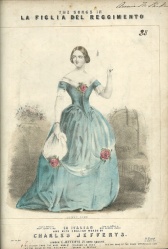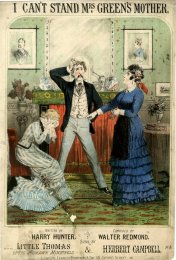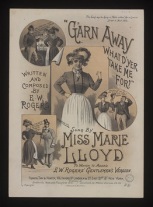This post is aimed not just at musicians but anyone out there who may have an interest in researching or just appreciating the wonderfully rich resource that is illustrated sheet music.
At the risk of stating the obvious, ‘sheet music’ is the generic term used to cover handwritten or printed musical notation. The terms ‘score’ and ‘part’ are more specific terms usually referring to music that is written for multiple players/singers. From at least the seventeenth century, popular songs and other short items of sheet music were issued with illustrations, either as part of a single sheet (along with the music and text) or on a separate cover.
Why would you want to find it?
Irrespective of the musical content, the illustrations on sheet music are a fabulous source in their own right. Here are some reasons you should take a closer look:
- Design/typography/printing history. Every type of method is represented from wood engravings to colour lithography. Some illustrators specialised in sheet music covers such as John Brandard and Alfred Concanen.
- Performance history. From ball rooms through music hall to jazz clubs, sheet music has documented the scenes, people, and themes of light music entertainment.
- Social/cultural history. Contemporary fashions, new inventions, and social stereotypes all feature on sheet music covers. All of life is represented and pretty much any topic you could think of has been covered by music’s illustrators.
- Portraiture. Many covers include illustrations or photographs of contemporary performers. Sometimes these images can be a rare source for long-forgotten celebrities.
Popular sheet music has often been viewed as ephemeral material so it’s not as easy to find as you might think. Music libraries catering to classical music students have tended not to actively collect, catalogue, or digitise popular song collections. And copyright law means that there are restrictions on what can be made available online.
That said, there are some really great collections out there, many curated by museums. Here are some places you can look. In most cases, images are free to use for personal, non-commercial research but do check the permissions on each site first.
- The V&A have a vast collection of sheet music, much of which is digitised. To browse, click on ‘more search options’, type “sheet music” into the object name/title box, and select ‘only records with images’.
- The Cuture Grid brings together collections from museums, galleries, libraries and archives across the UK – the site includes some unexpected sources of sheet music such as the Science Museum.
- The Spellman Collection of Victorian Music Covers is a huge collection housed at Reading University. It is included on the Culture Grid but also on VADS where it’s a bit easier to browse.
- The British Museum’s Collections Database is another great UK source, particularly for nineteenth-century covers.
- Further afield, the Sheet Music Consortium contains collections from US libraries. You can browse by title, subject, name and date published.
- Europeana brings together millions of items from Europe’s leading galleries, libraries, archives and museums, including sheet music.
- Flickr Commons is a subset of Flickr used by museums, libraries and archives across the globe. Search on “sheetmusic” (NB all one word) to search the sheet music tag.
- Lastly, this site is fabulous for French covers, particularly from the art nouveau and art deco periods. But beware: it’s curated by a private individual and copyright in some cases is dubious.

The songs in La Figlia del Reggimento (illustration of soprano Jenny Lind) [1840-43] Jerwood Library, Trinity Laban.
Here in the Jerwood Library we are starting to think about how we might make our illustrated sheet music more accessible. We have digitised some nineteenth century items here on Flickr Commons. We also have large amounts of twentieth-century illustrated covers in our Rita Williams Popular Song Collection, though, as yet, these are not digitised. And we are always acquiring new material through donation. So, if you want to know more, get in touch!
We’d also love to hear from you if you have used illustrated sheet music in your research – what did you use it for, how did you find it, what cataloguing/metadata did you find useful?







